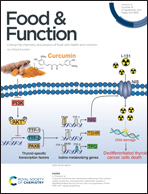Inhibition and interactions of alpha-amylase by daucosterol from the peel of Chinese water chestnut (Eleocharis dulcis)†
Abstract
The alpha-amylase inhibitory effect of daucosterol purified from the peel of Chinese water chestnut (CWC), a common Chinese vegetable, was assessed. The alpha-amylase inhibitory properties were elucidated by enzyme inhibition, fluorescence quenching and molecular docking experiments. It was found that three saponins from CWC peel exhibited potent inhibitory activity on alpha-amylase and daucosterol was found to be the main inhibitory factor against alpha-amylase with a mixed-type mode. Strong fluorescence quenching of alpha-amylase was observed under static fluorescence quenching with hydrophobic interactions with daucosterol. Molecular docking revealed that the conformation of daucosterol in the high-affinity sites I and II of alpha-amylase was optimum, and hydrophobic interactions were produced by daucosterol aglycone, and hydrogen bonding by the β-D-glucopyranosyl residue. Ingested daucosterol suppressed the elevation of blood glucose levels through inhibition of alpha-amylase in the small intestine in starch-loaded mice. This study provides data supporting the potential benefit of daucosterol from CWC peel in the treatment of diabetes.



 Please wait while we load your content...
Please wait while we load your content...